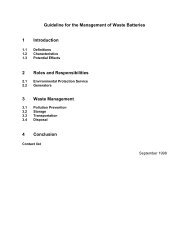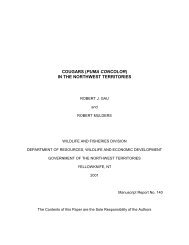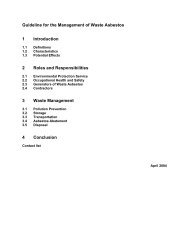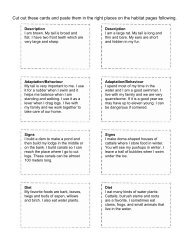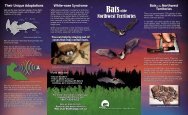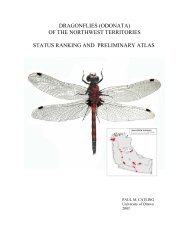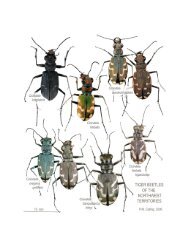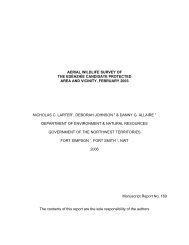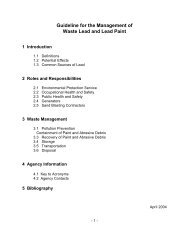Standard Operating Procedure (SOP) - Environment and Natural ...
Standard Operating Procedure (SOP) - Environment and Natural ...
Standard Operating Procedure (SOP) - Environment and Natural ...
- No tags were found...
Create successful ePaper yourself
Turn your PDF publications into a flip-book with our unique Google optimized e-Paper software.
<strong>St<strong>and</strong>ard</strong> <strong>Operating</strong> <strong>Procedure</strong> (<strong>SOP</strong>)<br />
Capture, H<strong>and</strong>ling & Release of Bears<br />
Wildlife Care Committee Primary Author: Dr. Marc Cattet Version 2 - 2011<br />
<br />
<br />
<br />
<br />
<br />
<br />
lower premolar, approximately 10 minutes prior to extraction. Of the two<br />
techniques, regional anesthesia is technically more difficult but provides more<br />
complete pain relief. Both techniques require prior instruction <strong>and</strong> training by<br />
a licensed veterinarian, but can be perfected easily with practice.<br />
Local anesthesia should be considered for other sampling procedures<br />
(aside premolar extraction) that are likely to elicit pain, e.g., tissue biopsy.<br />
Local (or regional) anesthesia is generally not required for most routine<br />
sampling procedures (blood collection, ear punch, skin/fat biopsy) because<br />
the pain elicited by these procedures is of short duration (when compared to<br />
tooth extraction) <strong>and</strong> adequately controlled by the immobilizing drug.<br />
However, where zolazepam-tiletamine (Telazol or Zoletil ) is used alone as<br />
the immobilizing drug, local anesthesia may be required because of the poor<br />
analgesic effect of this drug (Caulkett et al. 1999). In such case, infiltration of<br />
the biopsy/punch site with 2-3 ml of lidocaine (with 2% epinephrine)<br />
approximately 5 minutes before tissue collection will provide sufficient pain<br />
control <strong>and</strong> minimize bleeding.<br />
Least invasive procedures must be used for genetic (DNA) sampling, e.g.,<br />
hair follicle extraction, oral swab.<br />
Tissue biopsy for DNA analysis is unacceptable unless the biopsy samples<br />
are also required for other analyses, e.g., contaminants, stress indicators.<br />
If an ear tag is applied, the hole should be made with a sterile biopsy<br />
punch (6 mm diameter) <strong>and</strong> the tissue plug should be preserved for any<br />
analyses that require tissue samples.<br />
The ear tag stud is manually directed through the biopsy hole prior to<br />
securing the tag with the applicator.<br />
Sampling of blood <strong>and</strong> tissue should be performed only after appropriate<br />
training <strong>and</strong> adequate experience. Proper collection <strong>and</strong> h<strong>and</strong>ling <strong>and</strong><br />
preservation protocols must be followed in order to obtain useful field<br />
data.<br />
If the h<strong>and</strong>ling protocol requires weighing captured animals, the weighing<br />
must be done in the least stressful manner possible.<br />
Bears should not be suspended in a cargo net, or by “cuffs” attached to their<br />
four limbs, because of the potential for adverse health effects, e.g.,<br />
hypertension, regurgitation <strong>and</strong> aspiration (Cattet et al. 1999, Kreeger et al.<br />
2002). Instead, bears should be weighed by first positioning them sternally<br />
on a lightweight rigid platform (e.g., portable climbing ledges weigh 4-6 kg)<br />
<strong>and</strong> then suspending the platform from a pole, bipod, or tripod. If required, a<br />
portable climbing ledge can also be suspended safely beneath a helicopter<br />
for the purpose of moving a bear a short distance to safer terrain.<br />
At some point during h<strong>and</strong>ling, the anesthetized bear must be checked for<br />
wounds, injuries, <strong>and</strong> general condition <strong>and</strong> this information must be<br />
recorded on the field data sheet.<br />
This should include a thorough examination for injuries caused by the capture<br />
procedure. For example, wounds to claws <strong>and</strong> teeth are common in some<br />
type of culvert traps with extensive mesh, while edema (swelling), cuts,<br />
abrasions <strong>and</strong> fractures may occur with leg-hold snares.<br />
19



